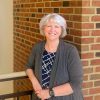Mary Tribble (WF Senior Advisor for Engagement Strategies) is our guest blog post author this week and she will be sharing her journey over the past several years–a genealogical and research journey which resulted in her recent book Pious Ambitions: Sally Merriam Wait’s Mission South 1813-1831. Her research on Sally (and Samuel) Wait has great meaning for the Wake Forest community, and is based on their diaries, letters, and manuscripts we hold here in Special Collections & Archives (SCA).
On January 26, 4:00-5:00, Mary will speak online via Zoom about her experiences in the archives as part of SCA programming and be available for a question and answer. SCA will share registration information in January, and the recording will be available afterwards on the ZSR YouTube channel. Her book will be available at the campus bookstore or can be ordered online here. Her work is a good reminder of the value of the handwritten document and the recording of ideas, events, and thoughts from long ago, and what they mean for us today. TZB
The journal was slim, its pages hand cut and sewn together some two hundred years ago. Its cover was decorated with hand-blocked paper that may have been a wallpaper remnant, according to a conservator. It was smaller than I had imagined it to be. After reading a transcribed version of the text for nearly two years, I had finally made my way to the Special Collections room at the Z. Smith Reynolds Library to hold it in my hands. And that made all the difference.
My research into the life of Sarah Merriam Wait, known as Sally to her friends and family, started in 2016 when I enrolled to earn a Masters in Liberal Studies at Wake Forest. I wanted to tell the story of my fourth-great grandmother, a nineteenth century woman who aspired to make her mark on the world. Her dream was to become a missionary in a far-flung place; in the end, she married the man who would establish Wake Forest College, settling northeast of Raleigh, North Carolina.
At 20 years of age, Sally began outlining the details of her conversion in the Baptist church and her subsequent courtship to Samuel Wait in Vermont in 1815. Approximately 6 x 4 inches and a half-inch thick, the journal was passed down carefully from generation to generation until it found its way in 1993 to the Special Collections, along with a large cache of letters and other documents. When the ephemera was donated to Wake Forest, my mother took note. She spent summers in the archives painstakingly transcribing the nineteenth century script. When I started my research, I relied on my mother’s work to study the hundreds of pages documenting Sally’s life.
I must have read the transcriptions of Sally’s journal a hundred times before I decided to go see it. Holding it in my hands transported me to Brandon, Vermont where Sally scratched out her inner thoughts on the sheets she carefully cut and sewed in place. As I turned the fragile pages, I saw something that eluded me in the typewritten version. There was a storyline to the journal. This wasn’t a personal diary detailing workaday events; Sally had constructed a story arc beginning with her first meeting with Samuel and continuing through her agreement to marry. It culminated with the conclusion of a church crisis. Throughout the narrative, Sally cast herself as a heroine in the story of a young woman’s evangelical conversion and courtship during a time of frequent and fervent revivals. The plot line had not been clear to me when I read the transcriptions; it only revealed itself when I held the book and turned its pages.
The facts that Sally wrote down aren’t the only details that help us understand her. The nature of the texts themselves give us nuanced insights into her state of mind. In the surviving sources—her journal, letters, and an essay book—we can witness Sally write herself into being. Her missives and musings revealed the transition from an aspirational missionary to a measured theologian and ministerial help-meet. Sally’s voice transformed as she was influenced by relationships, achievements, and heartbreaking setbacks that shaped her life. Through her intimate and sometimes performative words, we read the articulation of her highest ideals and her most vulnerable doubts.
While writing Pious Ambitions: Sally Merriam Wait’s Mission South 1813-1831, I searched for meaning in the surviving fragments of Sally’s life, reading significance into objects and words that represent only a fraction of the whole. I pulled at every thread to help me understand her life decisions. Yet, the narrative is incomplete. Even with the many personal papers, there is a part of this story we may never know. Documents cannot report intimate conversations, private arguments, or whispered concerns. They only include the events and opinions that Sally and her family were willing to commit to paper and then organize and preserve. The fact that these fragile items exist at all infer a venerated narrative that Sally’s descendants have shared from generation to generation. How Sally Wait herself measured her life in the end, we will never know.

1 Comment on ‘Pious Ambitions: Sally Merriam Wait’s Mission South 1813-1831’
Mary, thanks for following through on your search for Sally Wait’s life. I can’t wait to read the book. It is fascinating that you came to fully understand Sally and her life story only after holding the actual diary. I find that thrilling! Go archives!